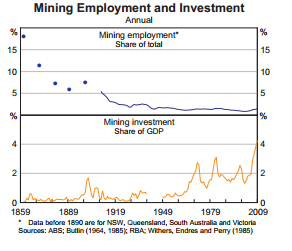|
YEAR |
Bread (4lb loaf) |
Milk (quart) |
Sugar |
Butter (lb) |
Potatoes (lb) |
Tea (lb) |
|
1867 |
5d to 9d |
6d |
N/A |
8d to 1s 8d |
½d to 1¼ d |
6d to 3s 3d (perlb) |
|
1877 |
6.5 d to 9d |
4d to 5d |
3½d to 5½d |
9d to 2s |
3/6 to 4/6d |
8d to 2s 6d |
|
1888 |
4½d to 6d |
5d to 6d |
2½4 d |
8d to 2s |
2s 6d to 15s 6d (50kg) |
6d to 1s 11d |
|
1901 |
3d |
4d |
9c* |
15d |
N/A |
6c (180g) |
|
1911 |
4d |
5d |
N/A |
18d |
N/A | N/A |
|
1940 |
5d |
7d |
N/A |
19d |
12d |
30d 10s (9lb) |
|
1950 |
8d |
11d |
5d |
26d |
24d |
36d (9lb) |
|
1960 |
18d |
18d |
10d |
57d |
47d |
77d |
|
1970 |
21c |
19c |
42c |
53c |
45c |
30c |
|
1980 |
54c |
63c |
90c |
$1.00 |
36c |
74c |
|
1990 |
$1.37 |
85c |
$2.17 |
$2.09 |
99c |
$1.64 |
|
1999 |
$2.33 |
$1.40 |
$2.21 |
$2.09 |
$1.55 |
$3.34 |
Other economical factors that may have affected Australia's economy included Australia's involvement in the Vietnam War
Sorry about crap formatting. This is just a placeholder after all... Information on real estate prices may be found at HERE. In 1964 the basic wage for a adult male was $30.70 weekly, however prices were much lower at that time (buying power was much higher - compare with prices table above)
The third boom was that in the 1960s/early 1970s. This boom was quite broadly based, but the key parts were sharp increases in mining of coal and iron ore, and the development of oil and bauxite discoveries. The background to this boom was that both the global and domestic economies were becoming increasingly stretched, with rising commodity prices and rising inflation more generally. Particularly important for Australia during this period was the economic development of Japan. As well as adding to the global demand for resources, this had particular significance for Australia because Japan’s proximity lowered transport costs and made certain mineral discoveries economically viable
SOURCE FOR ABOVE